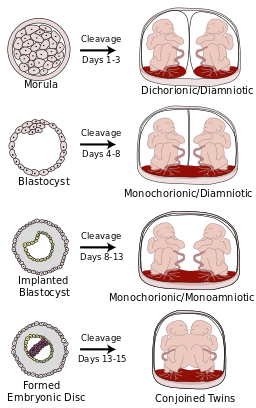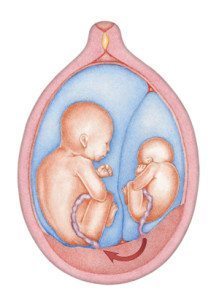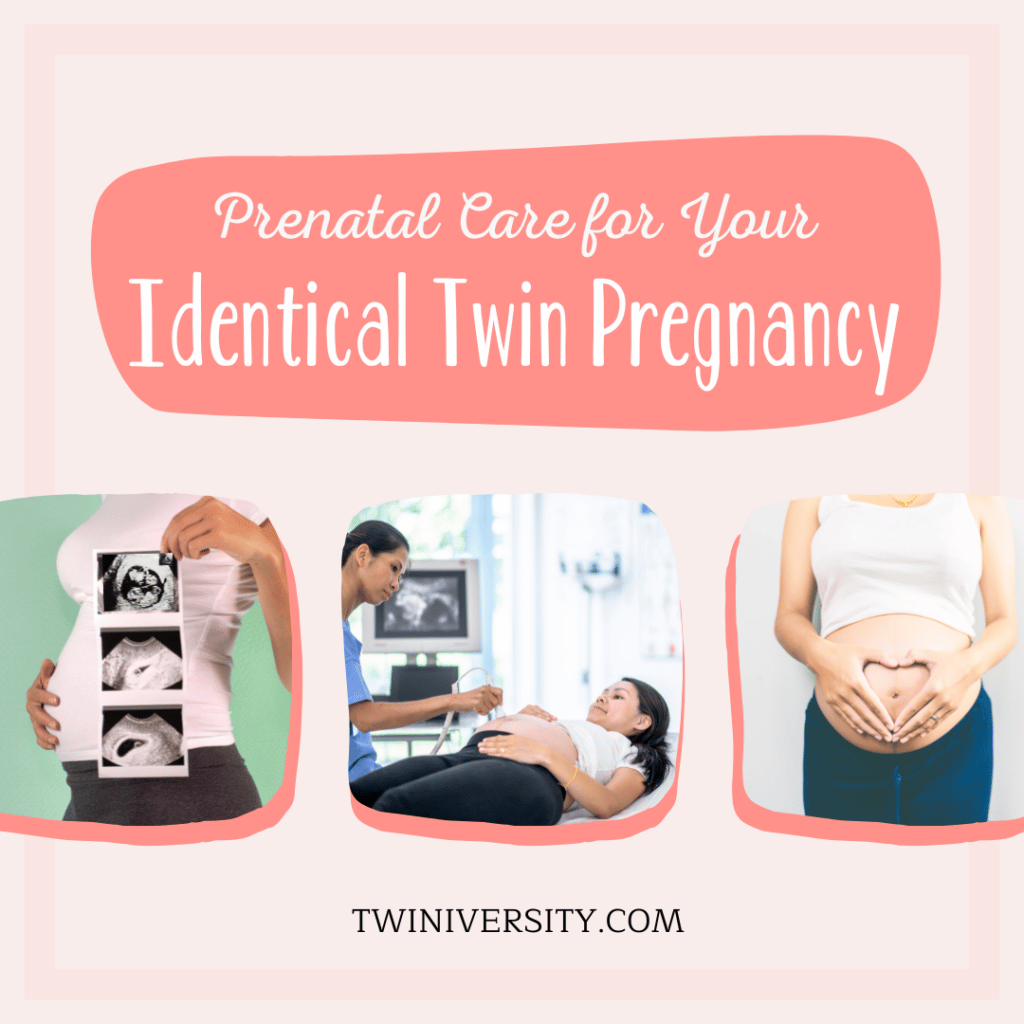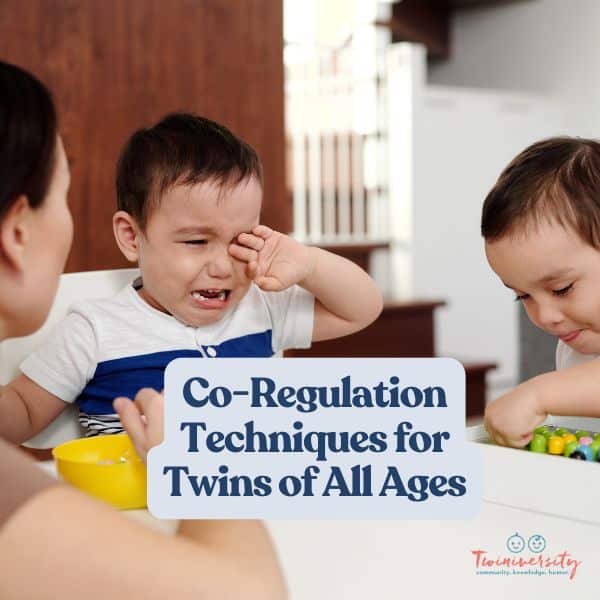Last updated on August 31st, 2022 at 02:57 pm
Finding out you’re having identical twins can cause a whirlwind of emotions, questions, and concerns. From that first doctor’s appointment, you’ll see how prenatal care for your identical twin pregnancy is different from a singleton pregnancy. This unique type of pregnancy often means extra ultrasounds, shorter gestation, and some scary potential complications. Don’t worry, we’ve got you covered with what to expect and how to ensure you get the best prenatal care for your identical twin pregnancy.
Disclaimer: All content on this Web site, including medical opinions and any other health-related information, is for informational purposes only and should not be considered to be a specific diagnosis or treatment plan for any individual situation. Use of this site and the information contained herein does not create a doctor-patient relationship. Always seek the direct advice of your own doctor in connection with any questions or issues you may have regarding your own health or the health of others.

Have you taken your expecting twins class yet? We offer a great class on demand so you can take it on your own schedule! There are so many video modules covering everything from your twins’ baby registry to your first week at home with twins! Sign up today to get started before your twins arrive.
What are identical twins?
Before we get into proper prenatal care for your identical twins, let’s find out what makes them special. Everyone knows there are two basic types of twins, fraternal and identical. It all comes down to zygosity. But what does that mean and how do doctors know which is which?
Fraternal twins are dizygotic. This means that two eggs are each fertilized by two different sperm. This results dichorionic-diamniotic twins where the two embryos each have their own placenta and amniotic sac. Fraternal twins are the most common and lowest risk type of twins. Read more about di-di twins here.
Identical twins are monozygotic. This means they that one egg (mono = one) is fertilized by one sperm. The egg then splits between 3 and 12 days after fertilization, resulting in two embryos that share one placenta and are therefore monochorionic.
The two most common types of identical twins are:
- Monochorionic Diamniotic (Mo-Di or Mono Di) twins share the same placenta and each baby has its own amniotic sac.
- Monochorionic Monoamniotic (Mo-Mo or Mono-Mono) twins share both the placenta and amniotic sac.

How do I know if I’m having identical twins?
Your doctor will do an ultrasound to determine the chorionicity (how many placentas) and amnionicity (how many amniotic sacs) of your twins. This is important as monochorionic twins require different prenatal care than dichorionic.
Keep in mind that knowing chorionicity does not always tell you what type of twins you’re having. While monochorionic always means identical, there are times when the presenting chorionicity does not accurately represent zygosity.
For instance, sometimes in a dizygotic (fraternal twin) pregnancy, the two placentas fuse together and appear as one. This is not a true monochorionic pregnancy but if the babies are of the same sex they may appear to be identical on an ultrasound.
Sometimes in a monozygotic (identical twin) pregnancy, the egg splits very early and develops two placentas. Known as di-di identical twins, they can appear to be fraternal on ultrasounds. Occurring in up to 30% of identical twin pregnancies, only a DNA zygosity test after birth can confirm that they are identical.

What prenatal complications can occur in an identical twin pregnancy?
Twin pregnancies are almost always high risk due to an increased risk of complications such as gestational diabetes, preeclampsia, high blood pressure, and preterm labor. Identical twins, however, have their own set of risks due to their shared placenta. Mono-mono twins also have the added risk of umbilical cord complications. Risks of identical twin pregnancy include:
Twin To Twin Transfusion Syndrome
Occuring in 15-20% of identical twin pregnancies, Twin-to-Twin Transfusion Syndrome (TTTS) is an uneven share of blood vessels connected to the placenta. One twin, the recipient, receives too much blood flow and the other twin, the donor, receives too little. This leads to an unequal distribution of amniotic fluid. The donor twin becomes dehydrated, and grows slower while the recipient grows larger. TTTS progresses quickly and can be fatal if not treated in time.
There is no way to prevent TTTS or tell if you are at risk of developing it. While there can be symptoms — the mother may feel discomfort, or measure large — the only way to accurately diagnose TTTS is through an ultrasound. This is most important in weeks 16-24, when the babies are at the highest risk of developing TTTS, but it can develop at any time.

Twin Anemia-Polycythemia sequence
Twin anemia-polycythemia sequence (TAPS) is an imbalance in red blood cells and hemoglobin. A form of TTTS, TAPS occurs later in pregnancy. It is detected by measuring the peak systolic velocity of the middle cerebral artery (MCA-PSV) via Doppler. The donor twin may be anemic while the recipient has too much blood and may require blood thinners after birth. With TAPS you will likely see one twin born very pale and the other dark red.
Selective Intrauterine Growth Restriction (sIUGR)
Selective Intrauterine Growth Restriction (sIUGR) occurs when there is an unequal placental share between the babies leading to abnormal blood flow. This causes slowed or even stopped growth for one baby. Expect weekly or even daily ultrasounds if the growth of the smaller baby falls below the 10th percentile. Depending on the severity of growth restriction, early delivery may be the best option.
Twin Reversed Arterial Perfusion sequence
Twin Reversed Arterial Perfusion sequence (TRAP) happens when the cardiac system of one twin fails to develop properly. The normally developing twin becomes a pump, doing double the work to pump for both babies. This puts extreme stress on the pump twin’s heart which can lead to cardiac failure. Your doctor will monitor blood flow patterns through a Doppler. If TRAP is suspected your MFM will do a fetal echocardiogram to confirm the diagnosis.

How do I get the best prenatal care for identical twin pregnancy?
While many identical twin pregnancies proceed without complication, proper prenatal care is the key to the safest pregnancy. Here are a few ways you can optimize your care.
Choose a Knowledgeable Medical Team
For optimum prenatal care for identical twin pregnancy, you need healthcare providers who understand identical twin pregnancy. This includes an obstetrician who is skilled in the care and delivery of identical twins.
You will likely also see a Maternal Fetal Medicine specialist (MFM)/Perinatologist. These specialists are trained in high-risk pregnancy care and are able to detect and address complications. MFMs are responsible for monitoring growth and fluid levels and performing in-depth ultrasounds at the most critical times of development.

Frequent Ultrasounds and Monitoring
The number one way to ensure a safe and healthy identical twin pregnancy is with frequent ultrasounds. Current guidelines recommend ultrasounds every two weeks starting at 12 weeks for mono-mono twins and at 16 weeks for mono-di twins. These scans monitor growth, fluid levels, and blood flow. You may receive extra anatomy scans as your doctor monitors for weight and growth discordance.
Identical twins require even more monitoring in the final weeks of pregnancy. Your doctor will monitor your cervix, the condition of the placenta and the babies’ position in the womb. You will likely have weekly scans to monitor for complications, plus non-stress tests to keep an eye on their heart rates and contractions. If any signs of preterm labor or complications arise you will likely be admitted to the hospital for medical intervention.
Prenatal Genetic Testing
An important part of any healthy pregnancy is genetic screening and diagnostics. These tests can provide insight into the risk and presence of chromosomal abnormalities. In the case of identical twins, genetic disorders may effect both babies. As such, it’s important to discuss your options for genetic testing as early as possible.

When should I deliver identical twins?
Preterm labor and premature birth are the most common complications of identical twin pregnancy, with over 60% of twins born before 37 weeks. However, even if you make it to that point, there are still risks. The shared placenta substantially increases the chances of complications and stillbirth for identical twins between weeks 33 and 38. As such, you will likely have an induction or scheduled c-section before 38 weeks.
It was previously recommended that identical twins deliver as early as possible. However, research now shows that there is no medical benefit to delivering mono-di twins prior to 36 weeks gestation. The ACOG now recommends mono-di twins deliver between weeks 34 and 38, and mono-mono twins between weeks 32 and 34. Mono-mono twins should be heavily monitored past 32 weeks due to the risk of cord entanglement.

How and where should I deliver identical twins?
Vaginal delivery is a choice for many identical twin pregnancies. However, a few things will determine your ability to do so. This includes the overall health of the babies and mom, their positions in the womb and any labor complications that arise. As a result, identical twin pregnancy is at higher risk for c-section. There is also a risk of the “double whammy” delivery. This is when baby A has vaginal birth and baby B requires a c-section. These risks prompt many expecting twins parents to choose a scheduled c-section to ensure safe delivery.
Early delivery can mean complications due to prematurity and/or NICU time for your babies. Some complications to prepare for include low birth weight, breathing, feeding, and temperature regulation. Even after a perfect pregnancy complications can arise postnatally. For the safest outcome, deliver your twins in a hospital that has at least a level III NICU.

Prenatal Care for Identical Twin Pregnancy
With the increased risk of complications, extra doctor’s appointments, and less time to prepare, identical twin pregnancy can be extra tough. Proper prenatal care and consistent monitoring are the keys to a safe and healthy prenatal and delivery experience for you and your identical twins. Trust your doctors, educate yourself, and take the time to process and accept your new reality. Most of all, try to enjoy your identical twin pregnancy, despite the anxiety. Your body is doing an amazing thing relax and enjoy the experience before the real fun begins!










